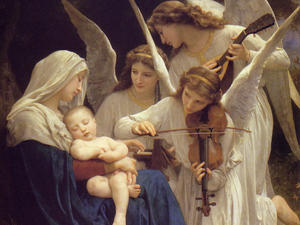Today, on the Feast of the Presentation of the Blessed Virgin, let’s consider the making – the crafting – of the Ark of the Covenant. Here it is, in part:
Moses said to the Israelites, “See, the Lord has chosen Bezalel, son of Uri, son of Hur, of the tribe of Judah, and has filled him with a divine spirit of skill and understanding and knowledge in every craft: in the production of embroidery, in making things of gold, silver or bronze, in cutting and mounting precious stones, in carving wood, and in every other craft. …
Bezalel made the ark of acacia wood, two and a half cubits long, one and a half cubits wide, and one and a half cubits high. The inside and outside were plated with gold, and a molding of gold was put around it. Four gold rings were cast and put on its four supports, two rings for one side and two for the opposite side. Poles of acacia wood were made and plated with gold; these were put through the rings on the sides of the ark, for carrying it — Exodus 35:30-32; 37:1-5.
The parallels of the Blessed Virgin Mary to the Ark are notable and frequently cited: She carried within her womb Christ who is Bread from heaven, the Great High Priest, the Greater Moses and the fulfillment of the Law. This  corresponds with the items stored in the Ark: Manna, the budded staff of Aaron, and the tablets of the law carved by Moses. But the account above of the making of the Ark shows other ways the type correspondences with the antitype.
corresponds with the items stored in the Ark: Manna, the budded staff of Aaron, and the tablets of the law carved by Moses. But the account above of the making of the Ark shows other ways the type correspondences with the antitype.
How was the Ark made? It was not made in heaven, but it was designed in heaven. Every detail of its perfect design was transmitted from heaven to ordinary humans who made it through ordinary human means. But note that the Ark itself, because of God’s Spirit upon the craftsmen, did not partake of the imperfections that in the ordinary course of event would have left some mark upon it. Not even the smallest flaw would be allowed to mar the perfection of the Ark because God filled the craftsmen with “a divine spirit of skill” for its making.
And what of the antitypical Ark, the Blessed Virgin? She came to be according to the ordinary way that children of men are borne — but perfect, her parents prevented by the Spirit of God from passing along to her any of their imperfections. From the moment of her conception she “was preserved immune from all stain of original sin” (CCC 491) that natural generation would have, in the ordinary course of events, caused in her.
The typical Ark was created to accompany the Israelites on their wilderness pilgrimage and into the Promised Land. It was designed to be carried by priests. Four rings were affixed to it and two poles slid through the rings so that it could be carried. Not merely for its own sake, or for the sake of its own beauty and perfection — as wonderful as those things were — but because it was there, with that Ark, that God choose to be present. The presence of the Lord traveled with the people as the Ark, carried by the priests, accompanied them.
So Mary, our Dear Mother, accompanies us on our pilgrimage through this life. The Church’s teaching carries and exalts Mary, by means of the Old and New Testaments and the Four Gospels, not merely for the sake of her beauty and perfection – as wonderful and lovely as they make her – but because it is with her that God chooses to be present to us.
There are many other ways that we can see Mary in connection with the Ark of the Covenant in Scripture and pondering them is always good for us. We are thereby reminded how much God cares for us and wants to be close to us, helping us on our pilgrimage through this life, while in Mary’s perfection we have a glimpse of the beauty of the life to come.
(© 2011 Mary Kochan)



